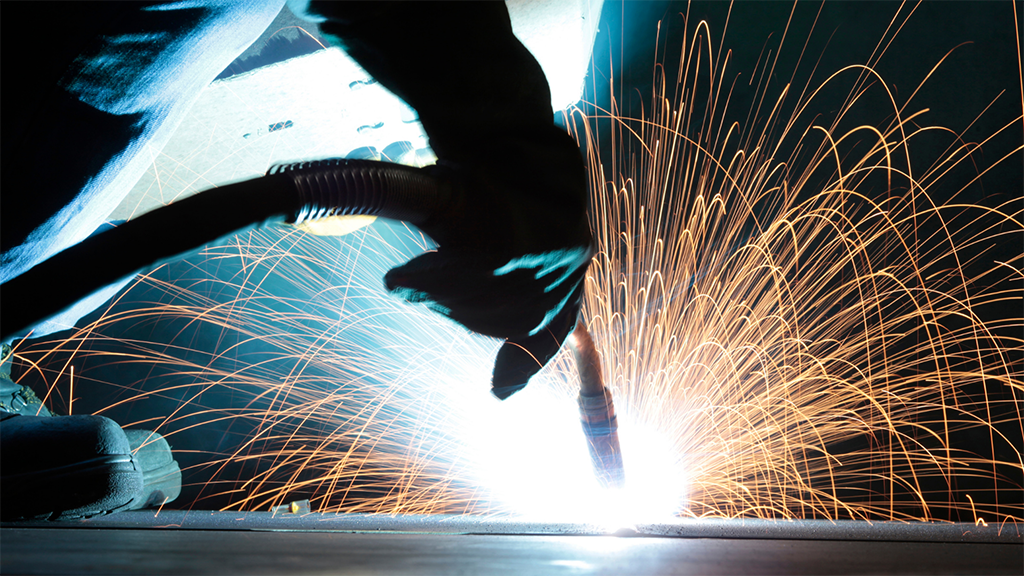Riverhawk produces the Free-Flex® Flexural Pivot, an encapsulated flexure bearing designed for high cycle oscillatory motion. We produce the original design that was patented back in the early 1960’s and has been used in thousands of applications since then. Among our most notable applications are high precision space mechanisms of all sorts. From scanning mirrors to beam steering mirrors to solar arrays, the pivot has performed flawlessly for years in the demanding environment of space. Over the years, the perception evolved that electron beam welding is the best, or only, option for construction of space bound pivots. Recent findings have shown that the choice between electron beam welding or brazed construction should be based on much more than just the environment. The most reliable flexural pivot construction depends more on the applied loads and rotational deflection of the application.
electron beam welding
Electron beam welding is a piece-by-piece operation in which the weld machine operator must make adjustments for proper weld penetration and proper alignment of the joint. Brazing is a batch process. An entire lot of pivots is coated with braze material and placed in a brazing furnace. The material melts and by capillary action, forms joints between the components. Very high braze repeatability within a given lot is achievable.
Several years ago a major space mechanism manufacturer placed an order for electron beam welded pivots that were to be subjected to moderate radial loads and very high angular rotation for a limited life of about 10,000 cycles. Traditional thoughts were that electron beam welded construction is stronger and thus more reliable under heavy cyclic loading. Before shipping the pivots we planned to cycle test all of them at a small angle. Our policy is that all electron beam welded flexural pivots for space or mission critical applications are to be cycle tested to weed out any potential weld defects that would cause early fatigue failure. The weld is difficult to inspect non-destructively but a cycle test will cause a detectable failure. When the welded pivots were cycle tested, all of them suffered premature fatigue failure across the flexures just above the weld joint. This resulted in late delivery on a critical project so an investigation ensued.
Obvious areas were investigated such as weld quality, process control, cleanliness, material conformity, and heat treatment. Many destructive cycle tests were performed on various weld configurations and we found that even with an absolute optimum electron beam weld joint, the welded pivot could not meet cyclic life catalog ratings for our standard brazed pivots. We found the reason to be in the geometry of the joint. Electron beam welding of the flexure to the core of the body leaves an area of non-penetration. If the weld were to penetrate further, it would damage the flexure. This non-penetration not only leads to a stress riser for fatigue, but also reduces the cross sectional area thru which the bending and radial forces act, thereby increasing the average stress in the section. A brazed joint, on the other hand, results in a smooth braze fillet at that same location. The braze fillet increases the cross section and more evenly distributes the bending stresses. Further testing on brazed and welded pivots confirmed that brazed pivots easily meet the catalog life cycle requirements but electron beam welded pivots should be de-rated by up to 40% for such applications.
We even found that by applying braze over the weld, we could significantly increase the fatigue life of the electron beam welded pivot.
So when should one, if ever, select electron beam welded pivots over brazed pivots? Welded pivot joints are inherently stronger under static loading. The weld strength is essentially equal to that of the parent material. When the application requires a pivot that can withstand very high static radial loads and is subjected to only small angular rotation of +/- 2 degrees or less, electron beam welding is generally preferred.
For applications with higher angular rotations or other significant cyclic loads, brazed construction is preferred. Brazed Pivots have been used successfully in space and aerospace for over 40 years. The braze material is an alloy of copper and silver with no flux or residues that could lead to outgassing or the release of particles. Braze construction Free Flex® Pivots are perfectly safe for space applications.
Over the years we have found that every application is unique and the right pivot design should be selected based not only on the factors included here but several others. If you have space or mission critical application, contact Riverhawk and we will help you identify all of the factors for your specific application so the right Free-Flex® pivot is selected.


